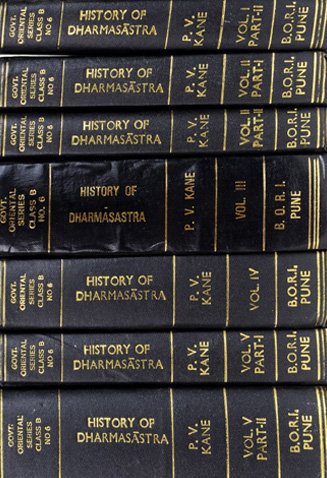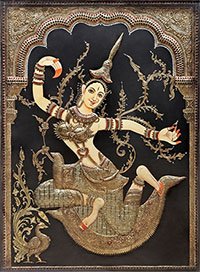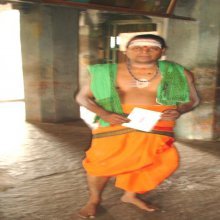Sandhi, Shandhi, Samdhi: 30 definitions
Introduction:
Sandhi means something in Buddhism, Pali, Hinduism, Sanskrit, the history of ancient India, Marathi, Jainism, Prakrit, Hindi. If you want to know the exact meaning, history, etymology or English translation of this term then check out the descriptions on this page. Add your comment or reference to a book if you want to contribute to this summary article.
Images (photo gallery)
In Hinduism
Ayurveda (science of life)
Source: Wisdom Library: Āyurveda and botanySandhi is a medical term used in Ayurveda meaning “joints”.
Source: archive.org: Sushruta samhita, Volume IIISandhi (सन्धि) refers to that “which serve as lines of demarcation of the circles of the eye” and are six in number:—
- the first binding the eye-lashes (Paksha-mandala) with the eyelids (Vartma-mandala),
- the second the eye-lids and the Sclerotic coat (Sveta-mandala),
- the third binding the latter with the Krishna-mandala (choroid),
- the fourth situated between the latter and the Drishti-mandala,
- the fifth lying in the interior comer (Kaninakas)
- and the last (sixth) in the exterior (posterior) corner (Apāngas) of the eye.

Āyurveda (आयुर्वेद, ayurveda) is a branch of Indian science dealing with medicine, herbalism, taxology, anatomy, surgery, alchemy and related topics. Traditional practice of Āyurveda in ancient India dates back to at least the first millenium BC. Literature is commonly written in Sanskrit using various poetic metres.
Dharmashastra (religious law)
Source: Wisdom Library: Dharma-śāstra1) Sandhi (सन्धि) refers to the “alliance”, as in, an alliance with an enemy king. Sandhi is considered to be one of the six constituents of state-craft that the King shall constantly ponder over. It is used throughout Dharmaśāstra literature such as the Manusmṛti and the Baudhāyana-dharmasūtra. (See the Manubhāṣya 7.160)
2) Sandhi (सन्धि) refers to “meeting point (junction)” of the boundaries between two villages. (See the Manubhāṣya, verse 8.251)
Source: Google Books: Manusmṛti with the Manubhāṣya1) Sandhi is alliance, entering into a compact, such as we shall help each other with elephants, horses and so forth. (See the Manubhāṣya verse 7.160 et. seq.)
Sandhi (alliance) is of two kinds—
- the compact that ‘both of us should march against a common enemy’,
- and the compact that ‘you march this way, I march the other way’.
2) Sandhi, Peace, is that by which a powerful enemy becomes friendly.
Source: Shodhganga: Facts of society in the ManusamhitaSandhi (सन्धि):—When the king knows that he can purchase his superiority in future, but at the present time, he shall suffer little pain or loss, then he must enter into alliance (sandhi) with an enemy king. When the king thinks all his subjects and allies fully contended and himself in a very exalted position in respect of his enemies, then he must declare war with his adversary.

Dharmashastra (धर्मशास्त्र, dharmaśāstra) contains the instructions (shastra) regarding religious conduct of livelihood (dharma), ceremonies, jurisprudence (study of law) and more. It is categorized as smriti, an important and authoritative selection of books dealing with the Hindu lifestyle.
Arthashastra (politics and welfare)
Source: Exotic India: Nitiprakasika of Vaisampayana (A Critical Edition)Sandhi (सन्धि, “peace”) is known to be of two types; it is entered into by the king for achieving his aim (i.e., supremacy) at the proper time. (Similarly) when the enemy acts abnormally, the twofold war (vigraha) is to be resorted to (whether the time for it is improper or proper). Making peace either alone or (sandhi) with some king and their being together can be made instantly. (see the Nītiprakāśikā 8.80)

Arthashastra (अर्थशास्त्र, arthaśāstra) literature concerns itself with the teachings (shastra) of economic prosperity (artha) statecraft, politics and military tactics. The term arthashastra refers to both the name of these scientific teachings, as well as the name of a Sanskrit work included in such literature. This book was written (3rd century BCE) by by Kautilya, who flourished in the 4th century BCE.
Natyashastra (theatrics and dramaturgy)
Source: Wisdom Library: Nāṭya-śāstra1) Sandhi (सन्धि) refers to “euphonic combinations” (in Sanskrit grammar) and forms part of the “verbal representation” (vācika), according to the Nāṭyaśāstra chapter 15. Vācika itself represents one of the four categories of representation (abhinaya).
(Description of Sandhi): “where a separated vowel or a consonant sandhīyate (“combines with another”) by ‘coming together’ (yogata) in a word or words, it is called sandhi (“euphonic combination”)” and “as due to the combination of words and the meeting of two sounds (lit. letters) their ‘sound sequence’ (karma-saṃbandha) sandhīyate (“develops in a combination”), it is called sandhi (“euphonic combination”)”.
2) Sandhi (सन्धि) refers to the five “segments” of the plot (itivṛtta or vastu) of a dramatic play (nāṭaka), according to the Nāṭyaśāstra chapter 21.
The five segments (sandhi), assigned to the principal plot (ādhikārika), are as follows:
- mukha (the opening),
- pratimukha (the progression),
- garbha (the development),
- vimarśa (the pause),
- nirvahaṇa (the conclusion).
The five segments (sandhi) give rise to the 64 limbs (aṅga) collectively known as the sandhyaṅga:
- mukhāṅga (the 12 limbs of the opening segment),
- pratimukhāṅga (the 12 limbs the progression segment),
- garbhāṅga (the 13 limbs of the development segment),
- vimarśāṅga (the 13 limbs of the pause segment),
- nirvahaṇāṅga (the 14 limbs of the conclusion segment).
There are also twenty-one sandhyantara (‘categories of contents’), which give the segments their distinction.
3) Sandhi (सन्धि, “junction”) refers to ‘the resurfacing of the original juncture’ in which the plot was germinated. Sandhi represents one of the fourteen nirvahaṇasandhi (concluding segment), according to the Nāṭyaśāstra chapter 21. Nirvahaṇasandhi refers to the “segments (sandhi) of the concluding part (nirvahaṇa)” and represents one of the five segments of the plot (itivṛtta or vastu) of a dramatic composition (nāṭaka).
(Description of Sandhi): “the coming up of the opening (mukha) and the seed is called a juncture (sandhi)”.
4) Sandhi (प्रवृत्त) refers to one of the two limbs (aṅga) belonging to Antarā type of song (dhruvā) defined in the Nāṭyaśāstra chapter 32.9-16. Accordingly, “depending on different conditions, the dhruvās are known to be of five classes”.

Natyashastra (नाट्यशास्त्र, nāṭyaśāstra) refers to both the ancient Indian tradition (shastra) of performing arts, (natya—theatrics, drama, dance, music), as well as the name of a Sanskrit work dealing with these subjects. It also teaches the rules for composing Dramatic plays (nataka), construction and performance of Theater, and Poetic works (kavya).
Purana and Itihasa (epic history)
Source: Wisdom Library: Bhagavata PuranaSandhi (सन्धि):—Son of Prasuśruta (son of Maru). He had a son named Amarṣaṇa. (see Bhāgavata Purāṇa 9.12.7)
Source: archive.org: Shiva Purana - English TranslationSandhi (सन्धि) refers to the “period of conjunction”, as defined in the Śivapurāṇa 1.13, “The last yāma (3 hours) of the night is called uṣā and the latter half of it is sandhi (period of conjunction). A Brahmin shall get up at that hour and answer the calls of nature. It must be in a place far off from the house. It must be a covered place. He shall sit facing the north. If it is not possible due to any obstacle he can sit facing other directions”.

The Purana (पुराण, purāṇas) refers to Sanskrit literature preserving ancient India’s vast cultural history, including historical legends, religious ceremonies, various arts and sciences. The eighteen mahapuranas total over 400,000 shlokas (metrical couplets) and date to at least several centuries BCE.
Jyotisha (astronomy and astrology)
Source: Wikibooks (hi): Sanskrit Technical TermsSandhi (सन्धि).—The inter-space between the foot of an altitude and the foot of the flank-side from whose tip the altitude is drawn, usually in a quadrilateral. Note: Sandhi is a Sanskrit technical term used in ancient Indian sciences such as Astronomy, Mathematics and Geometry.

Jyotisha (ज्योतिष, jyotiṣa or jyotish) refers to ‘astronomy’ or “Vedic astrology” and represents the fifth of the six Vedangas (additional sciences to be studied along with the Vedas). Jyotisha concerns itself with the study and prediction of the movements of celestial bodies, in order to calculate the auspicious time for rituals and ceremonies.
Kavya (poetry)
Source: Google Books: Indian Kāvya LiteratureSandhi.—As a rule the refrain verses in a sandhi are all in the same metre. The sandhi has an opening verse in that same metre. Thus a sandhi has a certain unity conferred by this refarin metre ‘entwining’ it.

Kavya (काव्य, kavya) refers to Sanskrit poetry, a popular ancient Indian tradition of literature. There have been many Sanskrit poets over the ages, hailing from ancient India and beyond. This topic includes mahakavya, or ‘epic poetry’ and natya, or ‘dramatic poetry’.
Shaivism (Shaiva philosophy)
Source: Shodhganga: Temple management in the ĀgamasSandhi (सन्धि) refers to the intersection of two yāma periods, where a single yāma equals to three hours.—A day consists of eight yāma (24 hours), or sixty ghaṭikā (1 ghaṭikā = 24 minutes). The intersection of two yāma periods is called sandhi, thus there are eight sandhi in a day. A single nityapūjā session should be performed within a sandhi period. The Kāmikāgama specifies that pūjā should start from the beginning and end with nṛtta, and be completed before the sandhi period is over, to avoid doṣa or error. Hence a pūjā session is commonly called “sandhipūjā”. The three sandhis at early morning, mid-afternoon and night are considered mahāsandhi. The others are called upasandhi.

Shaiva (शैव, śaiva) or Shaivism (śaivism) represents a tradition of Hinduism worshiping Shiva as the supreme being. Closely related to Shaktism, Shaiva literature includes a range of scriptures, including Tantras, while the root of this tradition may be traced back to the ancient Vedas.
Shaktism (Shakta philosophy)
Source: Google Books: ManthanabhairavatantramSandhi (सन्धि) refers to “(the rules governing the) conjunction (of vowels)” (in Sanskrit).—The union of opposites on the analogy of sexual union and, indeed, its concrete realisation through it, is also represented by a sonic hexagon in Kashmiri Śaivism as it is in the Kubjikā sources. [...] According to Abhinavagupta the sonic equivalent of this hexagon (ṣaḍara) is the letter AI. In accord with the normal rules governing the conjunction (sandhi) of vowels in Sanskrit, the letter E is formed by the fusion of A, which represents Anuttara, the male Absolute, with I the cosmogenic Will (icchā) that issues from it through the force of its inner emission (visarga). [...]

Shakta (शाक्त, śākta) or Shaktism (śāktism) represents a tradition of Hinduism where the Goddess (Devi) is revered and worshipped. Shakta literature includes a range of scriptures, including various Agamas and Tantras, although its roots may be traced back to the Vedas.
Yoga (school of philosophy)
Source: ORA: Amanaska (king of all yogas): A Critical Edition and Annotated Translation by Jason BirchSandhi (सन्धि) refers to the “joints of one’s body”, according to the Jayākhyasaṃhitā verse 33.19.—Accordingly, “[The Yogin] should make the joints of his body loose (srastāṅga-sandhi), his chest broad and shoulders comfortable. Having made his arms relaxed, he should slightly tilt the head [down]”.

Yoga is originally considered a branch of Hindu philosophy (astika), but both ancient and modern Yoga combine the physical, mental and spiritual. Yoga teaches various physical techniques also known as āsanas (postures), used for various purposes (eg., meditation, contemplation, relaxation).
Sports, Arts and Entertainment (wordly enjoyments)
Source: archive.org: Syainika Sastra of Rudradeva with English Translation (art)Sandhi (सन्धि) refers to the “joints” (of the fingers of the feet of a Hawk), according to the Śyainika-śāstra: a Sanskrit treatise dealing with the divisions and benefits of Hunting and Hawking, written by Rājā Rudradeva (or Candradeva) in possibly the 13th century.—Accordingly, [while discussing the yellow-eyed division of hawks]: “The following are the good points common to all these birds, namely, the ‘stalke’ (leg) should be short, round, thick and strong, the feet should have long fingers, well-set in their joints (suśliṣṭa-sandhi-bandha) and with fierce nails. Their whole make should be like the Svastika mark (+)”.

This section covers the skills and profiencies of the Kalas (“performing arts”) and Shastras (“sciences”) involving ancient Indian traditions of sports, games, arts, entertainment, love-making and other means of wordly enjoyments. Traditionally these topics were dealt with in Sanskrit treatises explaing the philosophy and the justification of enjoying the pleasures of the senses.
In Buddhism
Tibetan Buddhism (Vajrayana or tantric Buddhism)
Source: MDPI Books: The Ocean of HeroesSandhi (सन्धि) refers to the “junctures” (throughout the body), according to the 10th-century Ḍākārṇava-tantra: one of the last Tibetan Tantric scriptures belonging to the Buddhist Saṃvara tradition consisting of 51 chapters.—Accordingly, “[...] [He should meditate on] moistures of pleasure of wisdom and means in all junctures (sandhi) throughout the body. He should visualize [himself (Heruka)] being splendorous with fires, [which assume the shape of] various [forms of] Heruka. The vow-observer should give turbans to the heads of all [Herukas] . [...]”.

Tibetan Buddhism includes schools such as Nyingma, Kadampa, Kagyu and Gelug. Their primary canon of literature is divided in two broad categories: The Kangyur, which consists of Buddha’s words, and the Tengyur, which includes commentaries from various sources. Esotericism and tantra techniques (vajrayāna) are collected indepently.
India history and geography
Source: Cologne Digital Sanskrit Dictionaries: Indian Epigraphical GlossarySandhi.—(EI 4; SITI), literally, ‘twilight’; but actually, ‘service in the temple in the morning and evening’; daily wor- ship in temples; special worship offered in the names of persons who arrange for it by creating endowments, etc. Note: sandhi is defined in the “Indian epigraphical glossary” as it can be found on ancient inscriptions commonly written in Sanskrit, Prakrit or Dravidian languages.
Source: Shodhganga: A translation of Jhaverchand Meghanis non translated folk talesSandhi refers to “One type of caste of Musalman. People of these caste, have originally came from Sindh. In 17, 18 century when quarrel regarding possessions of territories and powers were going on at that time shrewdly taking advantage of stately disturbance they were doing business of robbery. Some people of these castes are engaged in farming”.—It is defined in the glossary attached to the study dealing with Gujarat Folk tales composed by Gujarati poet Jhaverchand Meghani (1896-1947)

The history of India traces the identification of countries, villages, towns and other regions of India, as well as mythology, zoology, royal dynasties, rulers, tribes, local festivities and traditions and regional languages. Ancient India enjoyed religious freedom and encourages the path of Dharma, a concept common to Buddhism, Hinduism, and Jainism.
Languages of India and abroad
Pali-English dictionary
Source: BuddhaSasana: Concise Pali-English Dictionarysandhi : (f.) union; junction; joint; connection; agreement; euphonic combination.
Source: Sutta: The Pali Text Society's Pali-English DictionarySandhi, (m. & f.) (fr. saṃ+dhā) 1. union, junction Miln. 330 (of 2 roads); Bdhgh on S. II, 270 (between 2 houses). ‹-› 2. breach, break, hole, chasm D. II, 83=A. V, 195; Th. 1, 786; J. V, 459. āloka° a window Vin. II, 172; sandhiṃ chindati to make a break, to break into a house D. I, 52; DA. I, 159.—3. joint, piece, link J. II, 88; Vism. 277 (the 5, of kammaṭṭhāna); Mhvs 33, 11; 34, 47; applied to the joints of the body Vism. 185 (the 14 mahā°); DhsA. 324.—4. connection, combination VbhA. 191 (hetuphala° & phalahetu° etc.).—5. euphonic junction, euphony, “sandhi” SnA 76. See pada°.—6. agreement Mhvs 9, 16.

Pali is the language of the Tipiṭaka, which is the sacred canon of Theravāda Buddhism and contains much of the Buddha’s speech. Closeley related to Sanskrit, both languages are used interchangeably between religions.
Marathi-English dictionary
Source: DDSA: The Molesworth Marathi and English Dictionarysandhi (संधि).—m pop. f (S) Junction, union, unitedness, joined or united state. 2 Joint, juncture, commissure, seam, line or point of junction. 3 A cleft, chink, fissure, cranny, chap, crack, chasm, breach, gap, slit, any interruption of continuity. 4 An interval, intermediate time or space. 5 A joint, knuckle, knot, an articulation generally. 6 Union or coalition of letters at the end or beginning of words entering into composition;--in obviation of dissonance or hiatus. 7 Aim; the mind as directed or applied, as attent or intent. v ṭhēva. Ex. bhikṣuka paikyāvara sandhi ṭhēvūna yajamānācēṃ ārjava karitō. 8 A period at the expiration of a Yuga or age, equaling one sixth of its duration, intervening between it and the succeeding Yuga: also a period of the same length as the Satya Yuga occurring at the end of each Manwantara and each Kalpa. 9 A hole made in a wall or underneath it, to enter a building for hostile or felonious purposes; a breach, a mine &c. 10 fig. The exactly opportune or suitable period or point of time; the critical juncture; the time and tide; the nick: also conjuncture or juncture generally. Ex. tukā mhaṇē aiśā sandhīṃ || ālī vaiṣṇavācī māndī ||. 11 fig. Connection or combination under the amicable or social relation, but, especially, the renewal of interrupted connection,--re-union, reconciliation, peace.
--- OR ---
sāndhī (सांधी).—f Joint, juncture: also chink, cranny &c. See sāndha.
Source: DDSA: The Aryabhusan school dictionary, Marathi-Englishsandhi (संधि).—f Junction. An arrival. Union. Aim. The nick, opportunity.
--- OR ---
sāndhī (सांधी).—f Joint. Chink.
Marathi is an Indo-European language having over 70 million native speakers people in (predominantly) Maharashtra India. Marathi, like many other Indo-Aryan languages, evolved from early forms of Prakrit, which itself is a subset of Sanskrit, one of the most ancient languages of the world.
Sanskrit dictionary
Source: Cologne Digital Sanskrit Dictionaries: Shabda-Sagara Sanskrit-English DictionarySandhi (सन्धि).—m.
(-ndhiḥ) 1. Union, junction, connection, combination. 2. Peace, making peace, pacification. 3. A hole, a chasm. 4. A hole made in a wall or underneath it to enter a building for hostile or felonious purposes, a breach, a mine, &c. 5. Breaking, dividing. 6. The vulva. 7. A division of a drama, apparently applicable to each subject represented or sentiment excited, as considered severally and detached from the rest, though contributing to the connection of the whole; contrast of incident, change of situation, transition of passion or emotion, &c. 8. An interval, a pause or rest. 9. A joint, an articulation of the body. 10. The union of letters, either at the end and beginning of different words, or in the middle of compound terms, to avoid dissonance or hiatus. 11. A period at the expiration of each Yuga or age, or one-sixth of its duration, intervening before the commencement of the next; a Sandhi, also, of the same length as the Satya-Yuga, occurs at the end of each Manwantara and each Kalpa. 12. Critical juncture, opportune moment. 13. (In mensuration,) The connecting link of a perpendicular. E. sama together, dhā to have or hold, aff. ki of either the act, condition or instrument; whence the word becomes applicable to a chasm, &c., as to an interval, which whilst it divides, also connects, two parts or places.
Source: Cologne Digital Sanskrit Dictionaries: Monier-Williams Sanskrit-English DictionaryṢaṇḍhī (षण्ढी):—[from ṣaṇḍha] f. (with yoni) the vulva of a woman that has no menstrual periods and no breasts, [Suśruta]
Source: Cologne Digital Sanskrit Dictionaries: Yates Sanskrit-English DictionarySandhi (सन्धि):—(ndhiḥ) 2. m. Union, junction; peace; a joint; a division; a hole; pause; vulva.
Source: DDSA: Paia-sadda-mahannavo; a comprehensive Prakrit Hindi dictionary (S)Saṃdhi (संधि) in the Sanskrit language is related to the Prakrit word: Saṃdhi.
Sanskrit, also spelled संस्कृतम् (saṃskṛtam), is an ancient language of India commonly seen as the grandmother of the Indo-European language family (even English!). Closely allied with Prakrit and Pali, Sanskrit is more exhaustive in both grammar and terms and has the most extensive collection of literature in the world, greatly surpassing its sister-languages Greek and Latin.
Hindi dictionary
Source: DDSA: A practical Hindi-English dictionarySandhi in Hindi refers in English to:—(nf) a treaty; conjunction, union; (in Grammar) morphophonemic change—euphonic junction of final and initial sounds (as [rama+ajna=ramajna, deva+indra=devendra]); liaison; a juncture or division of a drama (reckoned to be five, viz. [mukha, pratimukha, garbha, vimarsha] and [nirvahana]); joint; articulation; ~[kartta] a treatymaker, peacemaker; —[kala] a period of conjunction of two stages or states; —[patra] a treaty; -, [maitri] an alliance; —[bhamga] to break or violate a treaty; —[viccheda] separation of the constituents in a conjunct word; —[virama] armistice; -, [shamti] peace treaty..—sandhi (संधि) is alternatively transliterated as Saṃdhi.
...
Prakrit-English dictionary
Source: DDSA: Paia-sadda-mahannavo; a comprehensive Prakrit Hindi dictionary1) Saṃdhi (संधि) in the Prakrit language is related to the Sanskrit word: Saṃdhi.
2) Saṃdhi (संधि) also relates to the Sanskrit word: Saṃdhi.
Prakrit is an ancient language closely associated with both Pali and Sanskrit. Jain literature is often composed in this language or sub-dialects, such as the Agamas and their commentaries which are written in Ardhamagadhi and Maharashtri Prakrit. The earliest extant texts can be dated to as early as the 4th century BCE although core portions might be older.
Kannada-English dictionary
Source: Alar: Kannada-English corpusSaṃdhi (ಸಂಧಿ):—
1) [noun] a conjugating or being conjugated; union; conjunction; conjugation.
2) [noun] the state fact or condition of being together, associated; association; companionship.
3) [noun] agreement in opinion; consent; concurrence; accord.
4) [noun] a place or part where two bones or corresponding structures are joined, so that they can move; a joint.
5) [noun] a space or opening made by cleavage; a split; a cleavage.
6) [noun] a hole made in the wall of a house by a burglar (for entering into).
7) [noun] a depresssion in the ground (where water gets stagnated).
8) [noun] a right moment; an opportunity.
9) [noun] a period of time that demands careful and skillful management; a critical time.
10) [noun] a period of inactivity as during work or on a journey.
11) [noun] a period of time when a major transformation involving a lot of changes in day to day life, values in human life, etc. happens on a large scale in a society or in the world as a whole.
12) [noun] the light of the setting sun.
13) [noun] the external genital organs of the female, including the labia majora, labia minora, clitoris, and the entrance to the vagina; the vulva.
14) [noun] a vertical fold of cloth (as of a sari, dhōti, etc.).
15) [noun] a very small quantity or number.
16) [noun] a main division of a book, treatise or the like, usu. bearing a number or title; a chapter.
17) [noun] a folk epic or narrative poetry of a heroic personality.
18) [noun] (gram.) an euphonic junction of two words.
19) [noun] an agreement between two kings or nations; a pact; a covenant.
20) [noun] ಸಂಧಿಮಾಡು [samdhimadu] sandhi māḍu to mediate between two opposing, fighting parties and reconcile; to make a treaty of peace; ಸಂಧಿಮಾಡಿಕೊಳ್ಳು [samdhimadikollu] sandhi māḍikoḷḷu to enter into a pact with another king or nation; to covenant.
Kannada is a Dravidian language (as opposed to the Indo-European language family) mainly spoken in the southwestern region of India.
Nepali dictionary
Source: unoes: Nepali-English DictionarySandhi (सन्धि):—n. 1. union; conjunction; connection; transition; 2. a compact; an agreement; 3. alliance; league; friendship; treaty; 4. division; gap; pause; interval; 5. a joint; articulation;
Nepali is the primary language of the Nepalese people counting almost 20 million native speakers. The country of Nepal is situated in the Himalaya mountain range to the north of India.
See also (Relevant definitions)
Starts with (+80): Samdhia, Samdhia, Samdhibandha, Samdhibandhana, Samdhidosha, Samdhiga, Samdhigey, Samdhikarya, Samdhipadi, Samdhira, Samdhiraviya, Samdhisadhisu, Samdhishvara, Samdhisu, Samdhita, Samdhivatajvara, Samdhiviggahia, Samdhivikalpa, Sandhi-akshar, Sandhi-akshara.
Ends with (+127): Abhisandhi, Acasandhi, Acsandhi, Adasandhi, Adeshasamdhi, Adrishtapurushasamdhi, Adrishtasamdhi, Agamasamdhi, Ahisamdhi, Akshakasandhi, Alokasandhi, Amritasamdhi, Anabhisandhi, Angasandhi, Ansasandhi, Anusandhi, Anvaksharasandhi, Apangasandhi, Apratisamdhi, Araktasandhi.
Full-text (+629): Samdhi, Upacarita, Visamdhi, Kshaipra, Dvishamdhi, Kshiprasamdhi, Asthisandhi, Prashlishta, Janusandhi, Akama, Pragrihya, Avashamgama, Kapalasamdhi, Upadruta, Pravigraha, Visamdhika, Yathasamdhi, Anvaksharasandhi, Asandhi, Sandhivicakshana.
Relevant text
Search found 114 books and stories containing Sandhi, Saandhi, Samdhi, Saṃdhi, Sāndhī, Ṣaṇḍhī, Shandhi; (plurals include: Sandhis, Saandhis, Samdhis, Saṃdhis, Sāndhīs, Ṣaṇḍhīs, Shandhis). You can also click to the full overview containing English textual excerpts. Below are direct links for the most relevant articles:
Shishupala-vadha (Study) (by Shila Chakraborty)
Hīnasandhi (a) < [Chapter 3 - Six fold policies of a king (Ṣāḍguṇya)]
Ṣāḍguṇya according to Manu < [Chapter 3 - Six fold policies of a king (Ṣāḍguṇya)]
Hīnasandhi (b) < [Chapter 3 - Six fold policies of a king (Ṣāḍguṇya)]
Rig Veda (translation and commentary) (by H. H. Wilson)
Rig Veda 8.1.12 < [Sukta 1]
Annadatri-carita (study) (by Sarannya V.)
Dramatic Appraisal of Annadatri-carita (Introduction) < [Chapter 4 - Dramatic Appraisal of Annadatri-carita]
Bhakti-rasamrta-sindhu (by Śrīla Rūpa Gosvāmī)
Verse 2.4.235 < [Part 4 - Transient Ecstatic Disturbances (vyābhicāri-bhāva)]
Verse 2.4.236 < [Part 4 - Transient Ecstatic Disturbances (vyābhicāri-bhāva)]
Verse 2.1.332 < [Part 1 - Ecstatic Excitants (vibhāva)]
Jivanandana of Anandaraya Makhin (Study) (by G. D. Jayalakshmi)
Sandhis and Sandhyaṅgas < [Chapter 6 - Dramatic aspects of the Jīvanandana Nāṭaka]
Analysis of Nirvahaṇa Sandhi < [Chapter 6 - Dramatic aspects of the Jīvanandana Nāṭaka]
Analysis of Pratimukha Sandhi < [Chapter 6 - Dramatic aspects of the Jīvanandana Nāṭaka]
Dasarupaka (critical study) (by Anuru Ranjan Mishra)
Part 12 - Employment of the Juncture (sandhi) in a Nāṭaka < [Chapter 1 - Nāṭaka (critical study)]
Part 10 - Application of the Junctures (sandhi) in a Vyāyoga < [Chapter 5 - Vyāyoga (critical study)]
Part 3-6 - Prakaraṇa rules < [Chapter 10 - Prakaraṇa (critical study)]
Related products


